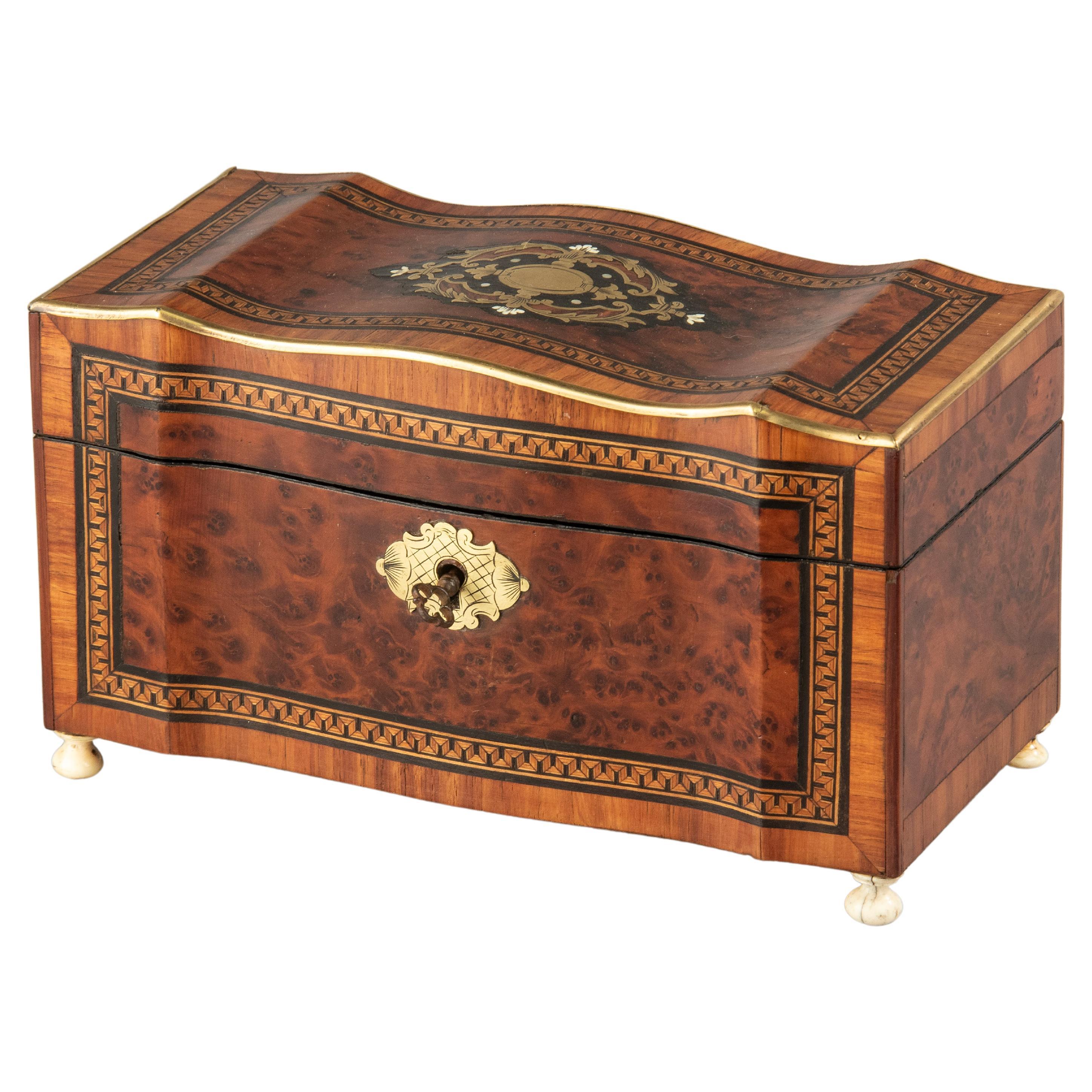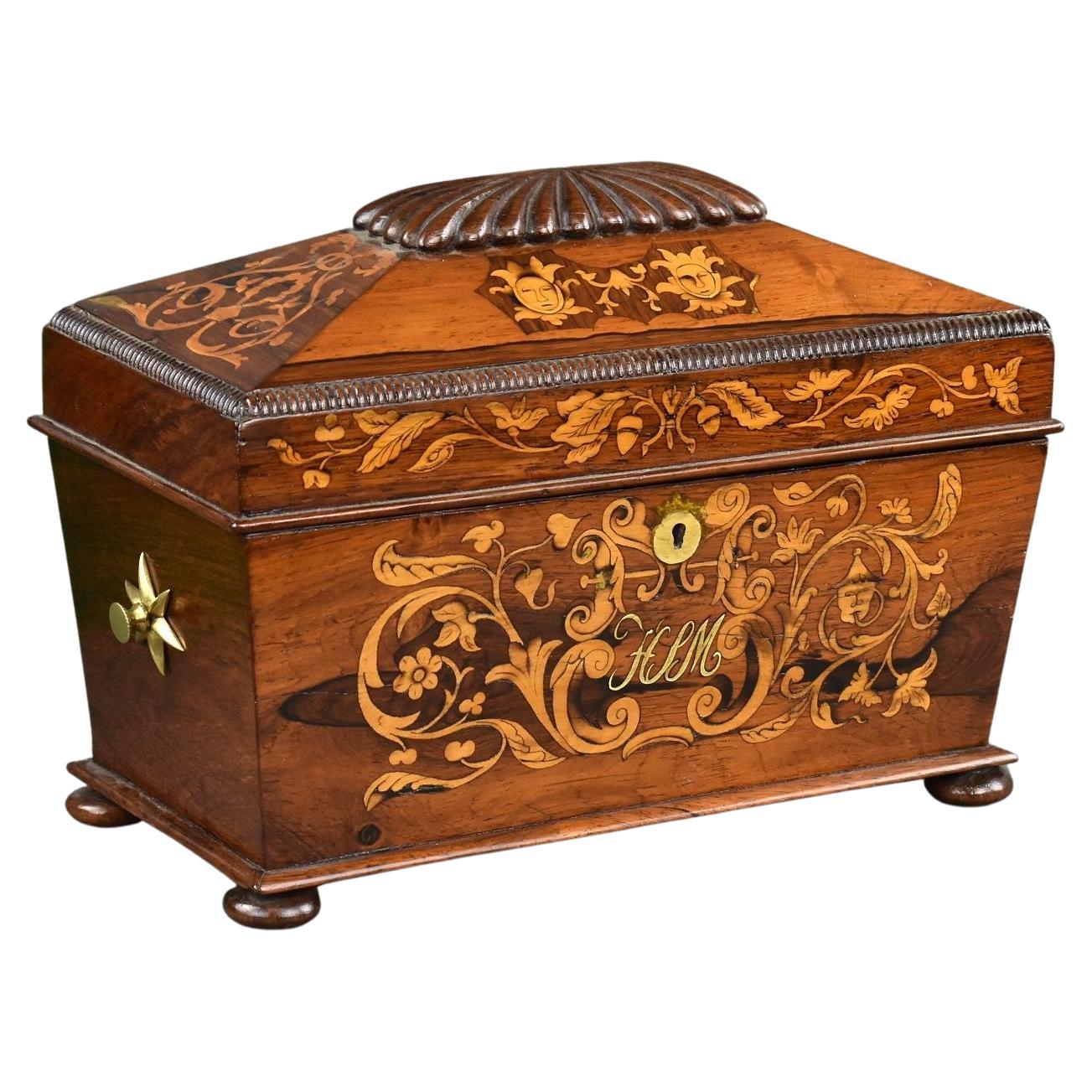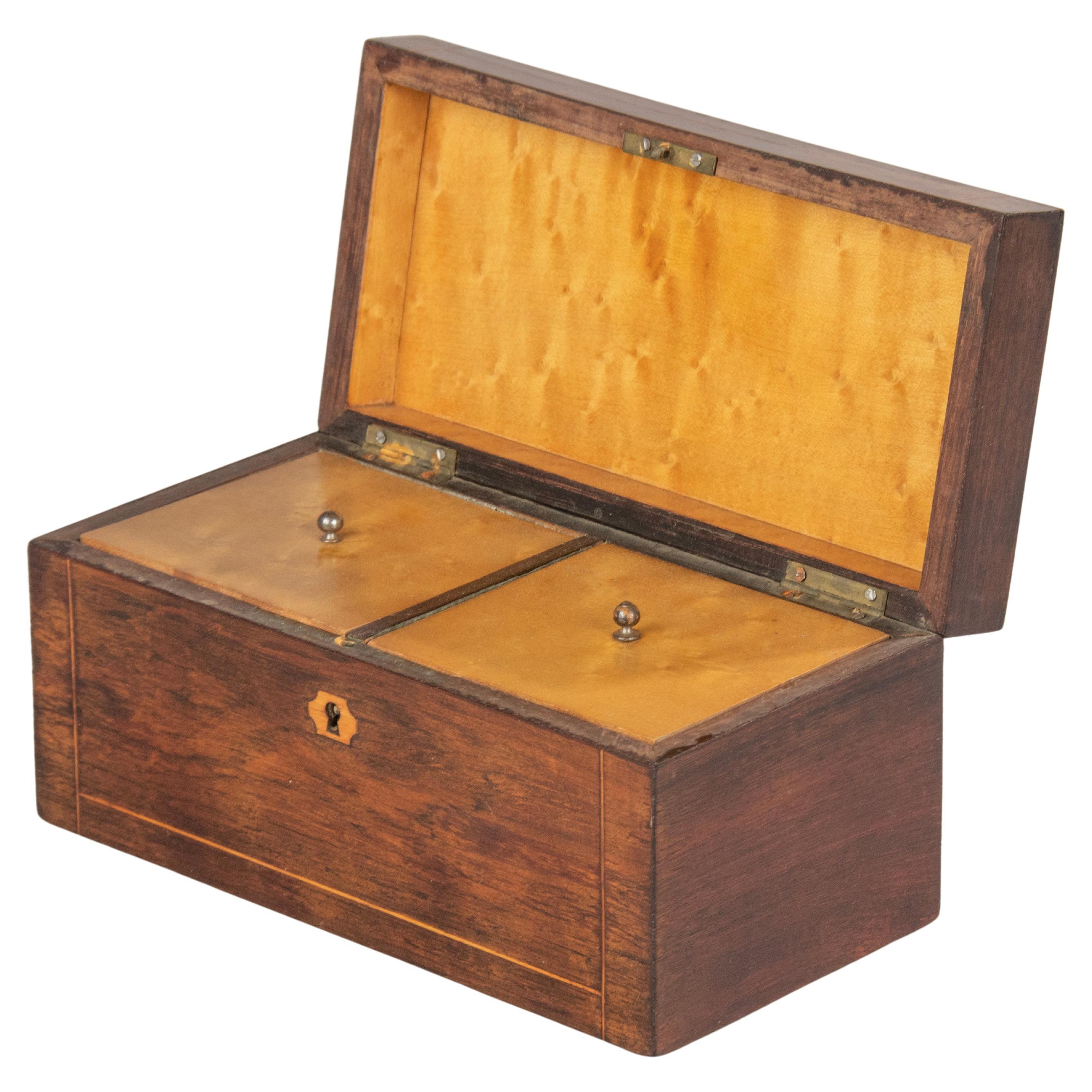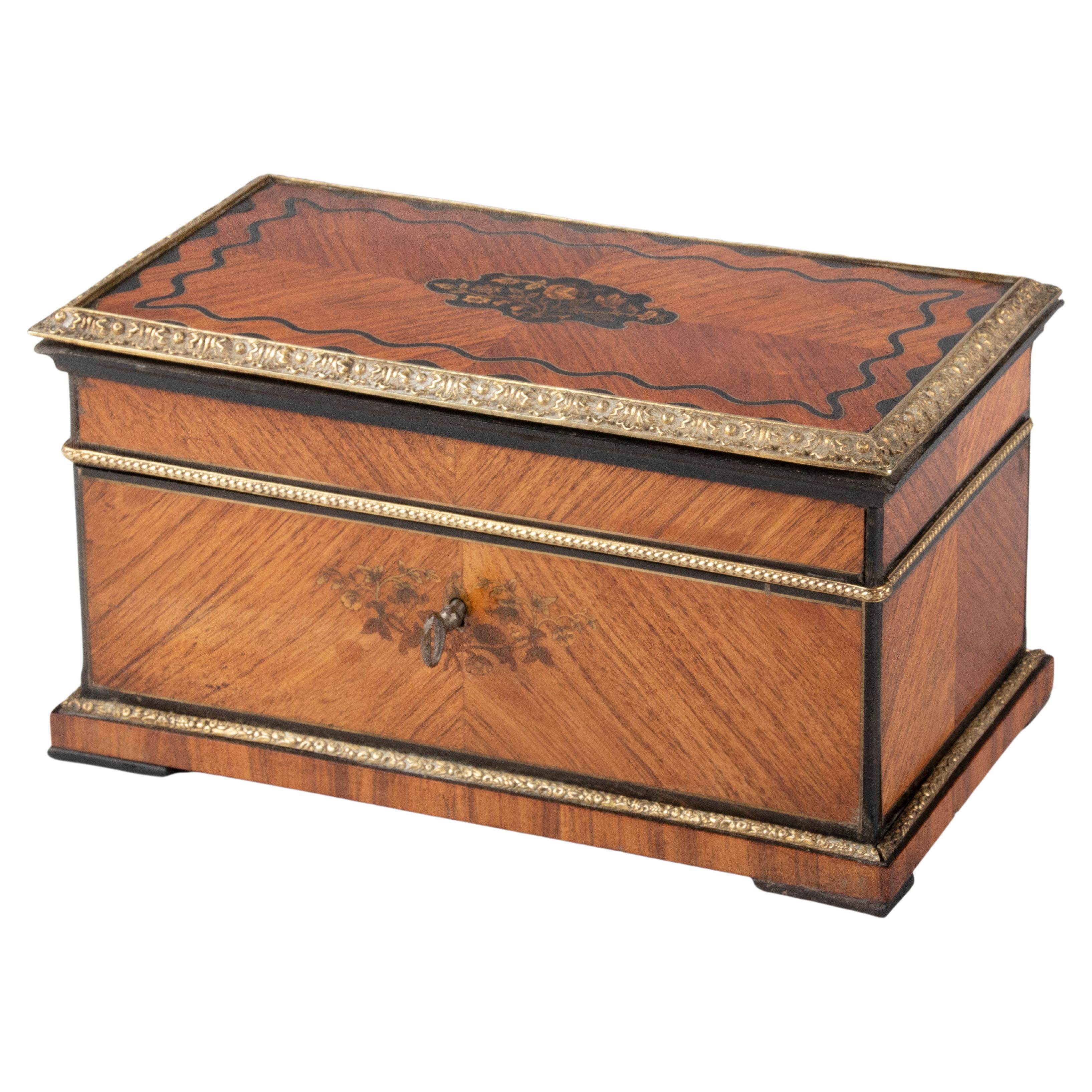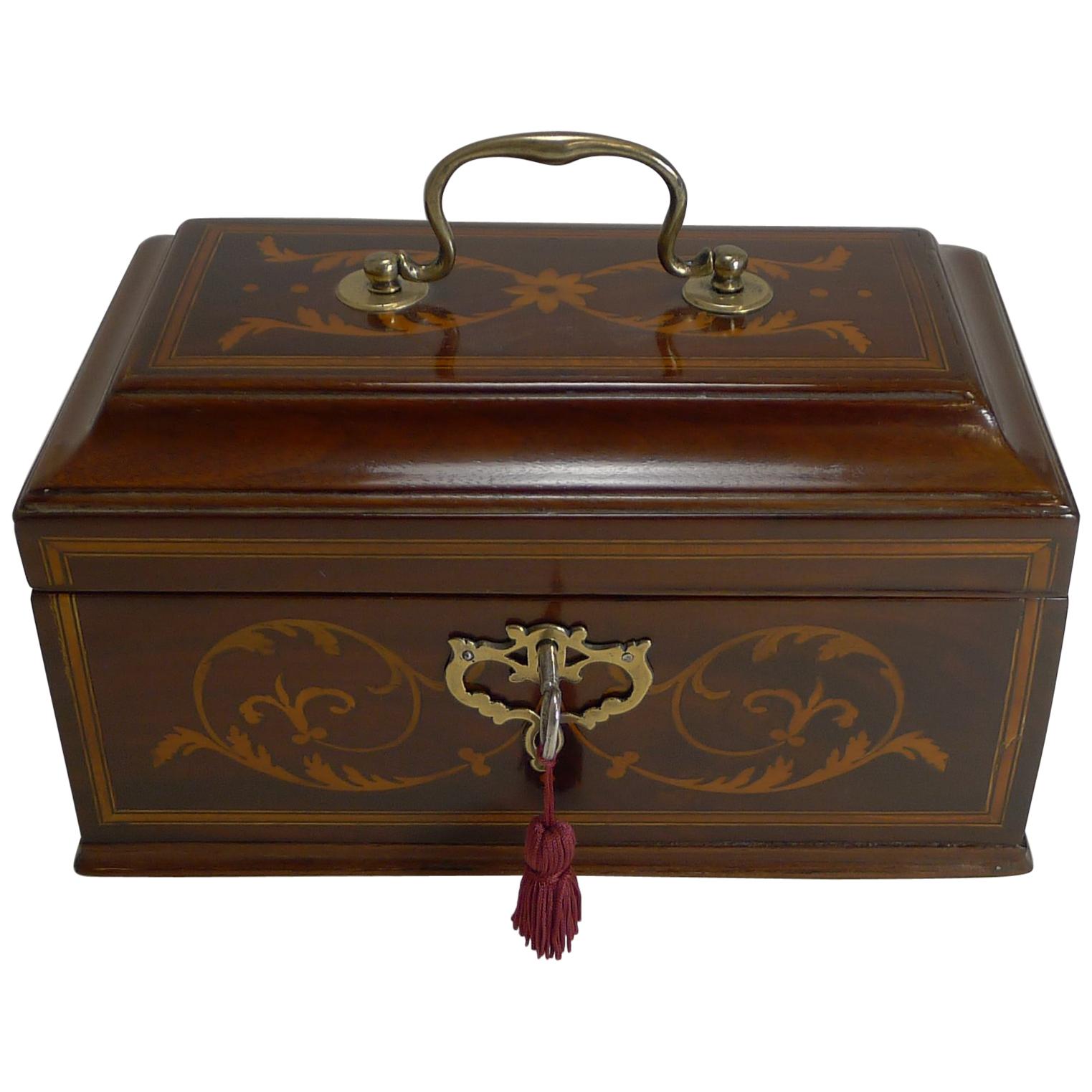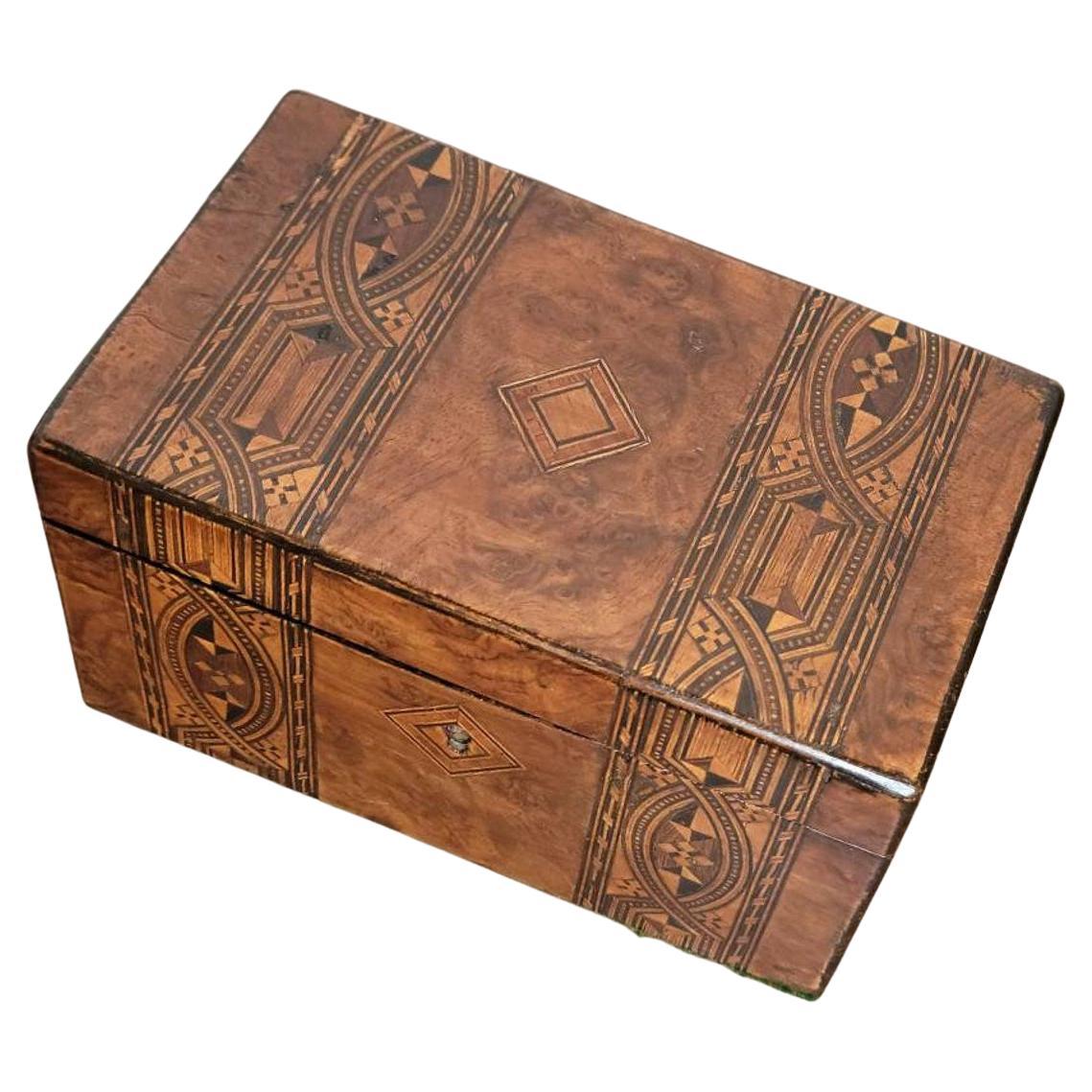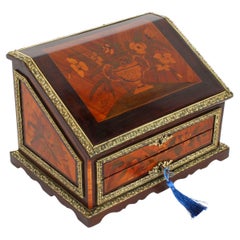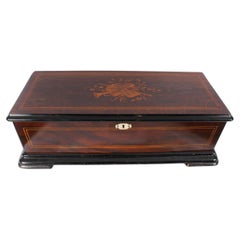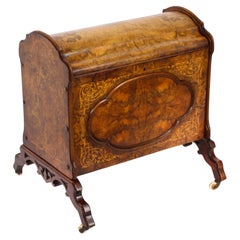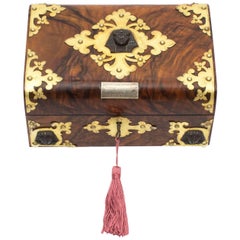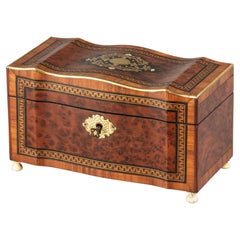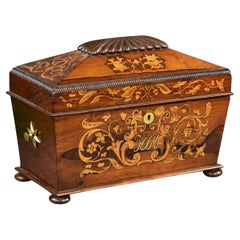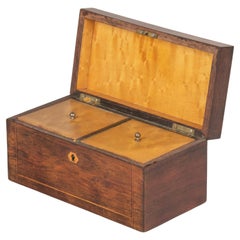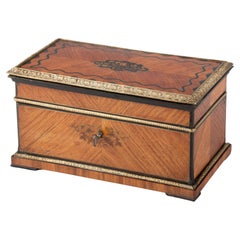Items Similar to Antique George IV Gonçalo Alves & Amboyna Marquetry Tea Caddy C1825 19th Century
Video Loading
Want more images or videos?
Request additional images or videos from the seller
1 of 22
Antique George IV Gonçalo Alves & Amboyna Marquetry Tea Caddy C1825 19th Century
$2,112.53
£1,550
€1,817.47
CA$2,914.42
A$3,240.95
CHF 1,702.22
MX$39,623.91
NOK 21,211.28
SEK 19,996.51
DKK 13,564.17
About the Item
This is an exquisite antique George IV Gonçalo Alves and amboyna marquetry inlaid tea caddy, circa 1825 in date.
It is beautifully decorated with superb marquetry decoration to the Gonçalo Alves and amboyna.
Of sarcophagus form, the lid enclosing an arrangement of two superbly decorated removable lidded canisters for the tea and a cut glass mixing bowl. The caddy is raised on decorative lion's paw feet.
Complete with original working lock and key.
There is no mistaking its unique quality and design which is sure to attract a lot of attention.
Condition:
In really excellent condition, please see photos for confirmation.
Dimensions in cm:
Height 24 cm x Width 41 cm x Depth 24 cm
Dimensions in inches:
Height 9 inches x Width 1 foot, 4 inches x Depth 9 inches
Tea caddy
is a box, jar, canister, or other receptacle used to store tea. The word is believed to be derived from catty, the Chinese pound. The earliest examples that came to Europe were of Chinese porcelain, and approximated in shape to the ginger-jar. They had lids or stoppers likewise of china, and were most frequently blue and white. Until about 1800 they were called tea canisters rather than caddies.
Earlier tea caddies were made of either porcelain or faience. Later designs had more variety in materials and designs. Wood, pewter,brass, copper and even silver were employed, but in the end the material most frequently used was wood, and there still survive vast numbers of Georgian box-shaped caddies.. These were often mounted in brass and delicately inlaid. Many examples were made in Holland, principally of the earthenware of Delft. There were also many English factories producing high quality goods.
As the use of the jar waned and the box increased, the provision of different receptacles for green and black tea was abandoned, and the wooden caddy, with a lid and a lock, was made with two and often three divisions, the centre portion being reserved for sugar.
The larger varieties were known as tea chests. As tea grew cheaper there was less concern with the appearance of caddies, and as a result they fell out of use. The use of "tea caddy" instead of "biscuit tin" fell out of use in the early 1900s.
Gonçalo Alves is a hardwood (from the Portuguese name, Gonçalo Alves). It is sometimes referred to as tigerwood — a name that underscore the wood’s often dramatic, contrasting color scheme.
While the sapwood is very light in color, the heartwood is a sombre brown, with dark streaks that give it a unique look. The wood’s color deepens with exposure and age and even the plainer-looking wood has a natural luster.
Two species are usually listed as sources for gonçalo alves: Astronium fraxinifolium and Astronium graveolens, although other species in the genus may yield similar wood; the amount of striping that is present may vary.
In the high tropical forests of Central and South America, well-drained soils furnish nutrients for a variety of dense, durable hardwoods sought for maritime use, heavyconstruction, and furniture. The Spanish began harvesting in Latin American forests in the early 1500s to provide timber for boatbuilding and repair. By the early 1900s, however, steel ships had replaced wooden ones, and the interest in tropical forests by both Europeans and Americans shifted to appearance-grade woods for furniture.
Although history fails to provide us with a shopping list of species from either harvest period, it's probable that the wood we know today as goncalo alves has always been sought. That's because goncalo alves, considered one of the most beautiful of tropical woods, has a tough reputation, too. Strong and durable, it's used for construction in its homeland and secondarily for fine furniture. Woodworkers elsewhere treasure the wood for decorative items and veneer accents.
Our reference: A3865
About the Seller
5.0
Platinum Seller
Premium sellers with a 4.7+ rating and 24-hour response times
Established in 1983
1stDibs seller since 2012
1,389 sales on 1stDibs
Typical response time: <1 hour
Associations
LAPADA - The Association of Arts & Antiques Dealers
- ShippingRetrieving quote...Shipping from: London, United Kingdom
- Return Policy
Authenticity Guarantee
In the unlikely event there’s an issue with an item’s authenticity, contact us within 1 year for a full refund. DetailsMoney-Back Guarantee
If your item is not as described, is damaged in transit, or does not arrive, contact us within 7 days for a full refund. Details24-Hour Cancellation
You have a 24-hour grace period in which to reconsider your purchase, with no questions asked.Vetted Professional Sellers
Our world-class sellers must adhere to strict standards for service and quality, maintaining the integrity of our listings.Price-Match Guarantee
If you find that a seller listed the same item for a lower price elsewhere, we’ll match it.Trusted Global Delivery
Our best-in-class carrier network provides specialized shipping options worldwide, including custom delivery.More From This Seller
View AllAntique French Marquetry and Ormolu Stationary Casket . 19th Century
Located in London, GB
This is a wonderful antique French Gonçalo Alves marquetry and ormolu mounted casket, circa 1860 in date.
The casket of bureau form has a lift up top and is inlaid with a marquetry ...
Category
Antique 1860s Decorative Boxes
Materials
Ormolu
Antique Swiss 8 Air Gonçalo Alves Musical Box 19th Century
Located in London, GB
This is a lovely antique Swiss 8 airs Gonçalo Alves cylinder music box, manufactured by Qualite Excelsior Sondrite Extra Puissant Harmonie, circa 1870 in date.
The Goncalo Alves case is inlaid and crossbanded with boxwood inlay and superb marquetry decoration of musical instruments. It is raised on a plinth base and is fitted with brass carrying handles.
The music box features a 28cm cylinder playing eight tunes with arrow and adjustable lyre damper, with handwritten "Tremolo a Zither" play sheet and makers plate for Qualite Excelsior Sondrite Extra Puissant Harmonie.
Condition:
In excellent working condition, please see photos for confirmation.
Dimensions in cm:
Height 28 cm x Width 66 cm x Depth 22 cm
Dimensions in inches:
Height 11 inches x Width 2 foot, 2 inches x Depth 9 inches
Music box
(also musical box) is a 19th/20th century automatic musical instrument that produces sounds by the use of a set of pins placed on a revolving cylinder or disc so as to pluck the tuned teeth (or lamellae) of a steel comb. They were developed from musical snuff boxes of the 18th century and called carillons à musique...
Category
Antique 1870s Decorative Boxes
Materials
Wood
Antique Victorian Burr Walnut & Inlaid Marquetry Canterbury Magazine Rack 19th C
Located in London, GB
This is a gorgeous antique Victorian burr walnut and marquetry inlaid enclosed Canterbury circa 1870 in date.
The grain of the burr walnut is truly beautiful. It features a hinged...
Category
Antique 1870s Decorative Boxes
Materials
Walnut
19th Century Victorian Burr Walnut Casket Sewing Box
Located in London, GB
This is a superb quality antique Victorian burr walnut casket, sewing box, with elaborate decorative brass and bronze mounts, circa 1860 in date.
The rectangular lid is beautifully decorated with cut brass mounts centred with a striking bronze sphynx...
Category
Antique 1860s English Victorian Decorative Boxes
Materials
Brass, Ormolu
Antique Dutch Marquetry Walnut Seven Drawer Chest Early 19th Century
Located in London, GB
This is a fabulous antique Dutch marquetry walnut chest of drawers, circa 1800 in date.
It has been accomplished in walnut with exquisite handcut marquetry decoration of urns and co...
Category
Antique Early 1800s Dutch Commodes and Chests of Drawers
Materials
Walnut
18th Century Dutch Burr Walnut Floral Marquetry Bureau
Located in London, GB
This is a wonderful antique late 18th century Dutch burr walnut and marquetry bombe' bureau.
It has been accomplished in burr walnut, with exquisite hand cut floral marquetry typica...
Category
Antique 1780s Dutch Secretaires
Materials
Walnut
You May Also Like
Late 19th Century Napoleon III Bombay Wood Marquetry Tea Caddy
Located in Casteren, Noord-Brabant
An antique French tea caddy in Napoleon III style, wit a bended “forme arbalète” lid. The box is veneered with various types of wood, burl wal...
Category
Antique 1860s French Napoleon III Tea Caddies
Materials
Brass
Victorian Rosewood Inlaid Marquetry Tea Caddy
Located in Chelmsford, Essex
For sale is this 19th Century Victorian antique rosewood inlaid marquetry tea caddy sarcophagus-form box, in good condition with marquetry to the top and front with brass star carryi...
Category
Antique Mid-19th Century Tea Caddies
Materials
Rosewood
Late 19th Century French Wood Veneer Marquetry Tea Caddy
Located in Casteren, Noord-Brabant
An antique French tea caddy in Napoleon III style. The box is made of veneer beechwood, with beautiful grain. The lid is in slayed with lighter maple ...
Category
Antique 1880s French Napoleon III Tea Caddies
Materials
Beech, Birdseye Maple
19th Century Napoleon III Wood Marquetry Teacaddy
Located in Casteren, Noord-Brabant
A refined antique French tea caddy from the end of Napoleon III. The box is beautifully inlaid with different types of wood and brass, outside around ...
Category
Antique 1880s French Napoleon III Tea Caddies
Materials
Brass, Bronze
Antique English Inlaid Mahogany Tea Caddy, circa 1790
Located in Bath, GB
A very handsome George III tea caddy, made from Mahogany and beautifully inlaid with panels and highly decorative foliate marquetry to the front and top. The top has a handsome cast ...
Category
Antique 1790s English George III Tea Caddies
Materials
Mahogany
19th Century English Tunbridge Ware Marquetry Tea Caddy
Located in Forney, TX
A well-made antique, circa 1830, English tea caddy with stunning marquetry inlays, warm coloring, superb detailing, and luminous rich patina!
When tea first arrived in Europe in t...
Category
Antique 19th Century English Regency Tea Caddies
Materials
Brass
